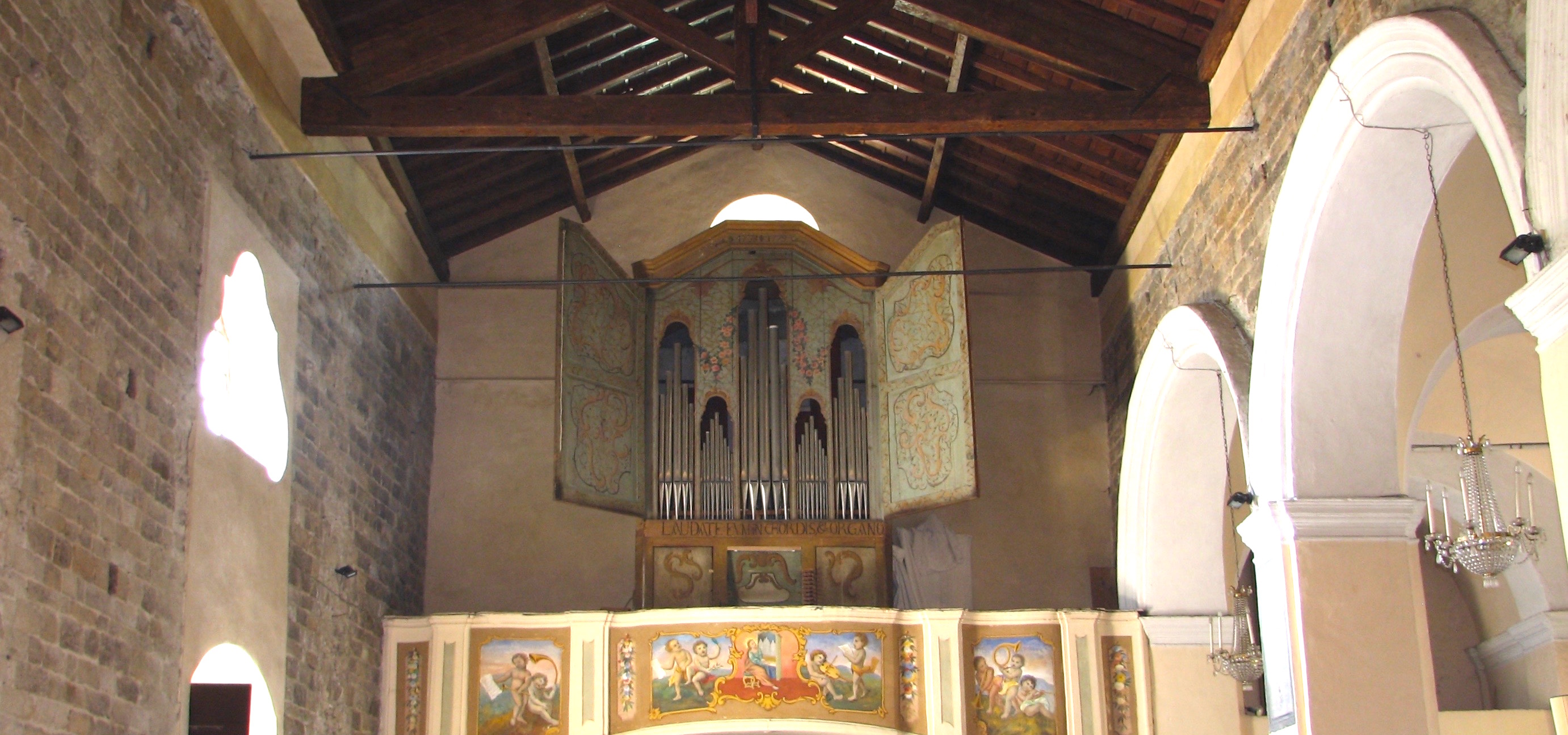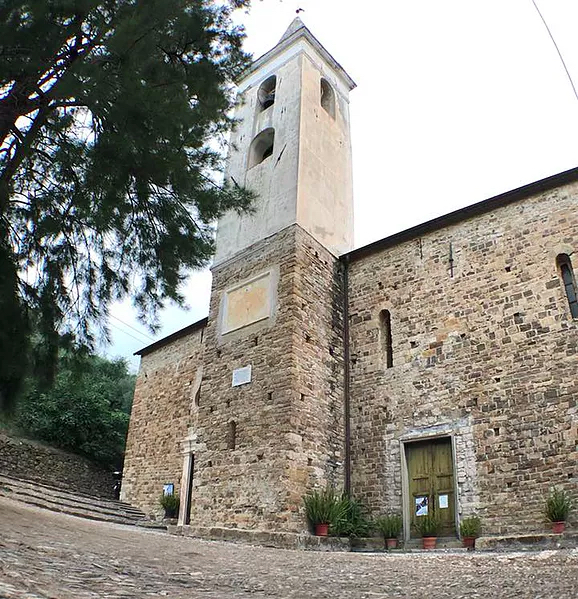



November 18, 2018
KIRK M. RICH
–––––––––––––––––––––––––––
The Italian Classical Organ at Imperia


November 18, 2018
KIRK M. RICH
–––––––––––––––––––––––––––
The Italian Classical Organ at Imperia


Situated along the Mediterranean Sea, Liguria, the northwestern coastal region of Italy, is home to several exquisite beach resorts. Sanremo, for instance, has been a tourist destination for almost 200 years, frequented by the likes of the nineteenth-century Russian Empress Maria Alexandrovna and Emperor Nicholas II. The Russian influence from a previous era is seen today in the Orthodox Church of San Basilio, its five onion domes towering over the Via Nuvoloni, while architectural characteristics of the Art nouveau can be seen in the Casinò Municipale just down the street.

Approximately 25 kilometers (15 miles) east of Sanremo lies Torrazza, an ancient village situated in the mountainous province of Imperia. Only accessible by car, the medieval Church of St. George the Martyr sits on a hill midway up a mountain. Consecrated in the year 1001, the current building displays architectural elements typical of a small gothic Romanesque church.
Nestled in a rear gallery of this modest space is an organ built by Giovanni Battista Ciurlo between 1788 and 1789. From the end of the eighteenth century through the middle of the nineteenth, the Ciurlo family was active building pipe organs in and around the Ligurian capital of Genoa. Although constructed near the end of the eighteenth century, this instrument is, in most ways, a prime example of an Italian Baroque organ. It was restored to playing condition in 2013 by Fratelli Carrara.
The Ciurlo organ consists of a single manual of four octaves, with short octave omitting low C-sharp, D-sharp, F-sharp, and G-sharp. The keys are of boxwood and ebony. A short octave of pedals operates a Subbasso 16’ and is permanently coupled to the manual.
Like Italian organs of the Renaissance, the Ciurlo instrument is based upon an 8’ Principale, the voicing of which is quite vocal:
Girolamo Frescobaldi: Toccata Quarta (Part I), performed by Kirk M. Rich.
Unlike the mixture stops of most northern European Baroque organs, the ranks of an Italian principal chorus or ripieno can be drawn separately, allowing a myriad of registrational combinations. The organ in Torrazza has the following ripieno — Principale until Vigesimanona — and some special additional stops listed below that:
| Italian | English | |||
|---|---|---|---|---|
| Principale | Principal | 8' | ||
| Ottava | VIII | Octave | 8' | |
| Decimaquinta | XV | Fifteenth | 2' | |
| Decimanona | XIX | Nineteenth | 1 1/3' | |
| Vigesimaseconda | XXII | Twenty-Second | 1' | |
| Vigesimasesta | XXVI | Twenty-Sixth | 2/3' | |
| Vigesimanona | XXIX | Twenty-Ninth | 1/2' | |
| Voce umana | Voce umana | 8' | ||
| Flauto in ottava | Flute | 4' | ||
| Cornetto | 3 voci | Cornet | III | |
| Subbasso (Ped.) | Subbass | 16' |
This recording of Toccata Quinta from Girolamo Frescobaldi’s Il libro secondo di Toccate demonstrates the resplendence of the Ciurlo organ’s full ripieno supported by pedal points on the 16’ Subbasso:
Girolamo Frescobaldi: Toccata Quinta, performed by Kirk M. Rich.
Of special note is the lack of a twelfth, or 2’ 2/3, which was rarely present in the ripieno of an Italian Baroque organ (instead, an open flute rank, the flauto in duodecima, is more common, though not in the case of the Ciurlo organ). Present, however, is the typical four-foot open flute, or flauto in ottava. In his L’arte organica (1608), organist and organ builder Costanzo Antegnati remarks that the flauto in ottava can be used alone, in music with divisions and canzonas, and that it can be combined with the Ottava. For all kinds of music and especially accompanying motets, Antegnati recommends combining the flauto in ottava with the principale.
In the following recording of Frescobaldi’s Toccata Seconda (also from Il libro secondo di Toccate) one can hear a variety of registrations to mark the constantly changing affect in this piece. Following Antegnati’s advice, the opening adagio is played on the solo Principale, followed by a livelier passage with the addition of the Ottava. After another more languid section, once again featuring the solo Principale, we hear the Principale and Ottava with Decimanona (8’, 4’, and 1’ 1/3). The work concludes with an example of a mezzo ripieno: 8’ through 1’, without the two uppermost ranks:
Girolamo Frescobaldi: Toccata Seconda, performed by Kirk M. Rich.
Another feature particular to the eighteenth-century Ligurian school of organ building is the Cornetto 3 voci, a three-rank flute cornet. The organ in Torrazza also has a mysterious sonority produced by the Voce umana, a principal rank of pipes tuned slightly sharp so that the sound undulates when combined with the Principale (the concept is similar to a voix celeste in French organs). According to Adriano Banchieri’s L’organo suonarino (1605), organists would play a long piece during and after the consecration of the bread and wine at the Mass, which became known as the “Elevation” toccata, and while the Voce umana was not typically found in Roman Baroque organs, builders in other regions included them for use in this type of piece. Here is the concluding section of Frescobaldi's Toccata Quarta, with the Principale and Voce umana:
Girolamo Frescobaldi: Toccata Quarta (Conclusion), performed by Kirk M. Rich.
Although dating almost 150 years after the death of Frescobaldi, the Ciurlo organ is an example par excellence of a western Italian baroque-style organ. Aside from its construction and design, the meantone temperament (in which most thirds are tuned mathematically pure, versus what we hear on most modern pianos — for more, see this introduction to our article about the arciorgano), which in this instrument is modified slightly from a traditional quarter-comma system, plays a decisive role in bringing ancient music to life.
For anyone interested in exploring Italian repertory on an historic instrument, Francesco Cera offers a three-day masterclass focusing on one Italian composer each summer in Torrazza. Registration is limited to six, and those who participate are given countless hours of attention from one of the great authorities on this music at the Ciurlo organ. This is a fantastic way to immerse oneself in music that is sometimes difficult to understand when adapted to instruments in other styles.
––––––––––––––––––––––––
Historic Organs of the World is a new series of short articles on Vox Humana, in which members of the Editorial Board present a less-known organ of historical and cultural significance every month. Articles include information about the instrument's history, photographs, and specification, as well as descriptions of what it's like to actually play the organ — the key action, what the organ sounds like at the keydesk versus in the room, the acoustics, and more, complete with short recordings. Through these tools, Historic Organs of the World seeks to demonstrate how these organs influence the interpretation of repertoire, and raise awareness of the great instruments that have helped shape every aspect of organ art.
Kirk M. Rich has performed recitals in venues such as St. Thomas Church (New York City), the Kennedy Center, and three national conventions of the American Guild of Organists. He has taken both third (2014) and second prize (2016) in the AGO’s National Young Artists’ Competition in Organ Performance, and his playing has been broadcast nationally on American Public Media's Pipedreams program. Currently a doctoral candidate at the University of Houston Moores School of Music, Kirk holds degrees from Indiana University’s Jacobs School of Music and the Oberlin Conservatory. His teachers include Robert Bates, James David Christie, Douglas Reed, and Christopher Young. Kirk is the Associate Director of Music and Organist at All Saints Episcopal Church in Atlanta.
The views and opinions expressed in this article are those of the author, and do not necessarily reflect the position of Vox Humana.